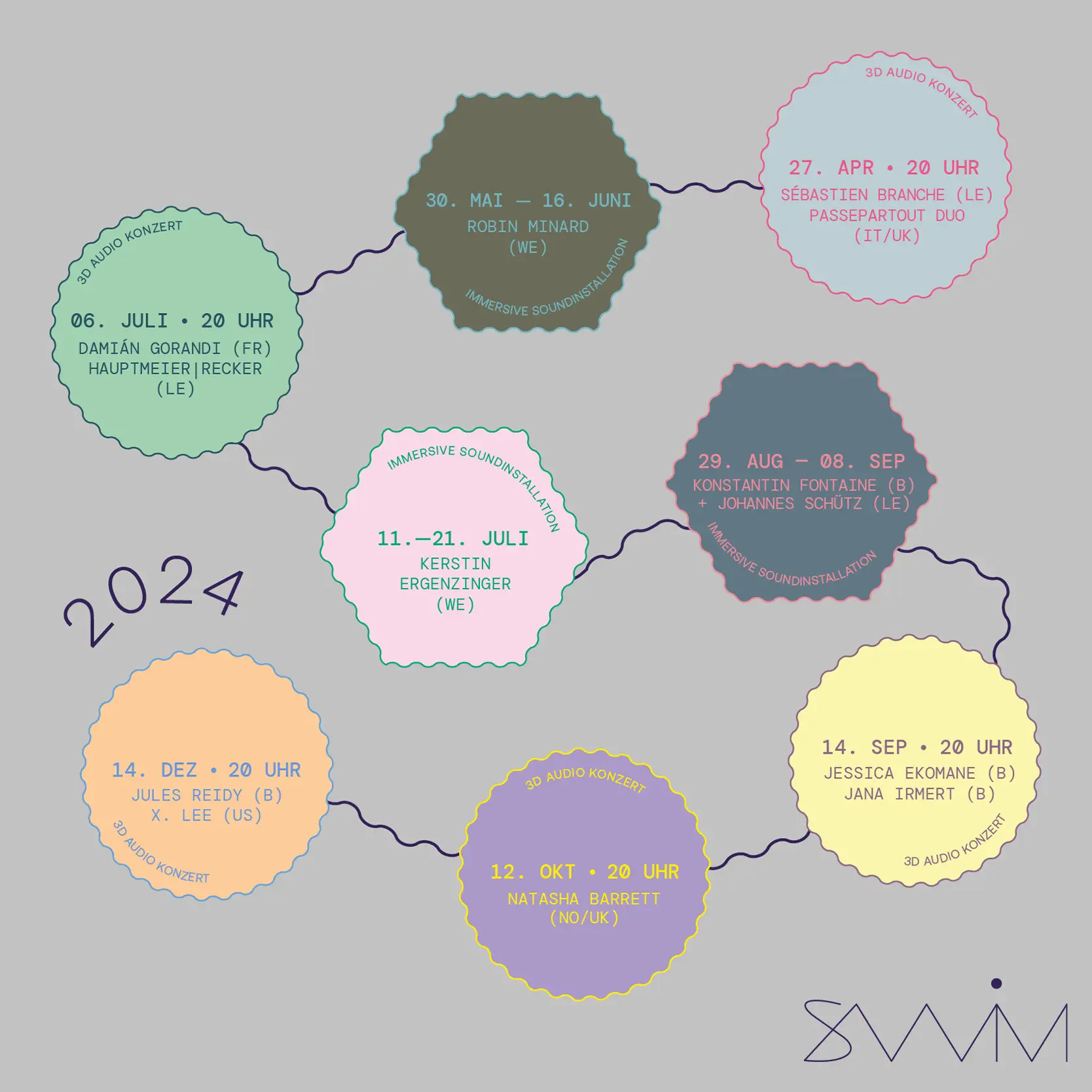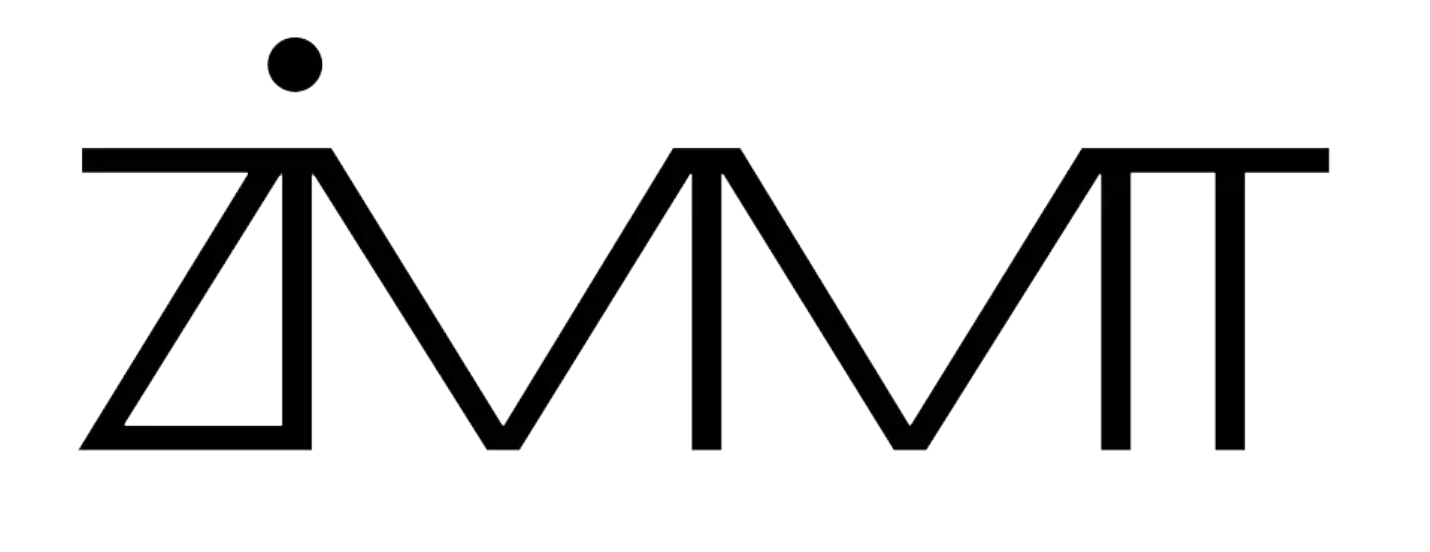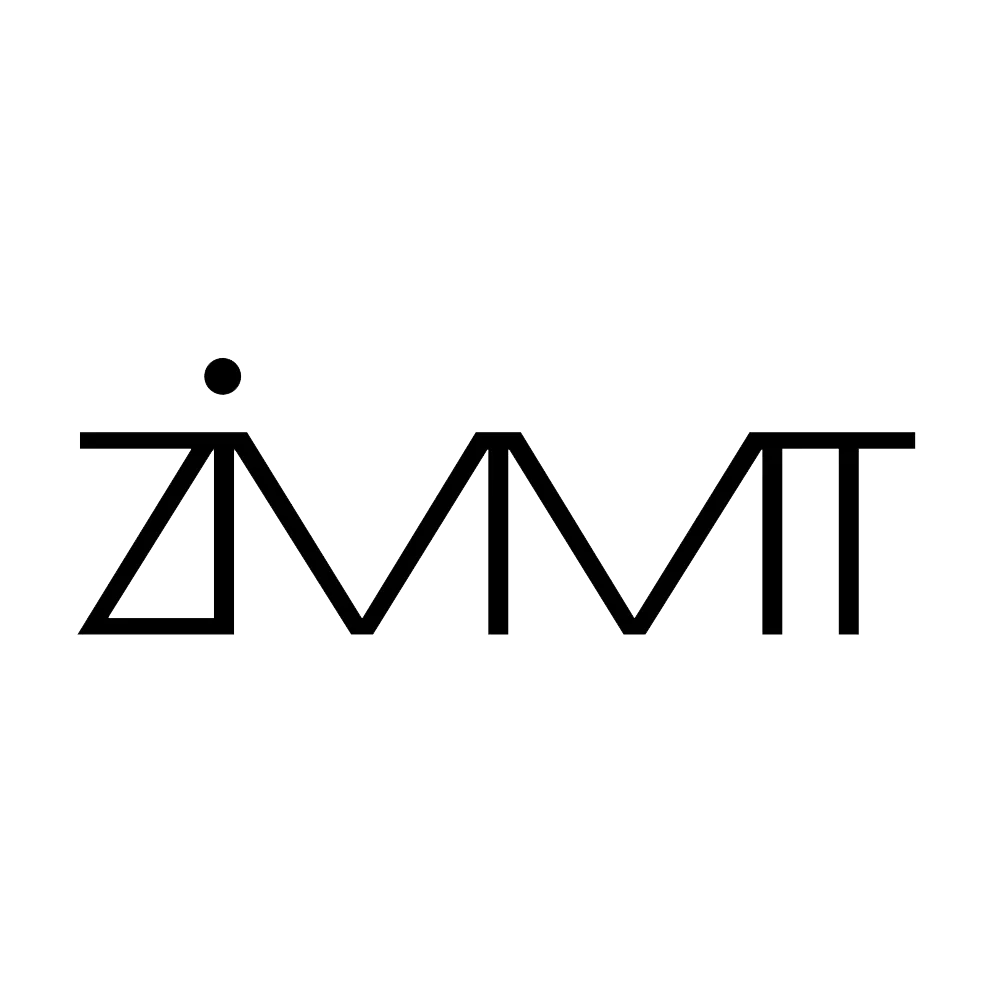
swim
With the swim series (spatial works and immersive music), ZiMMT 2024 invites you to throw musical habits overboard. Nine spatial concerts and three sound installations that build a bridge between several (electronic) genres bring up new questions. A broad spectrum of musical forms of expression from different genres will be integrated into immersive, expansive experiences.
15 very different local and international artists are part of swim. Their works range from multi-layered electro-acoustic compositions to experimental approaches rooted in the aesthetics of club music. swim merges different sound worlds and allows radical approaches to music production and performance to collide with existing ideas in a questioning way. What technical means are used and how do they expand musical expression? What happens to the role of the audience when they dive into virtual soundscapes in an immersive performance? The understanding of the term “instrument” is challenged as well: New instruments enter the stage and familiar ones find themselves in unfamiliar settings.
In three-day microresidencies, the musicians can develop their works in our spaces using 3D audio technology and try out new approaches. All concerts will be streamed live in high quality with binaural audio – for an immersive experience, on site and everywhere.
Passepartout Duo • Sébastien Branche
27. April / 7 pm door, 8 pm start of concert / 3D Audio Concert
Passepartout Duo
Drawing from a carefully selected palette of electro-acoustic textures and shapeshifting rhythms, Passepartout Duo’s work investigates the way in which we listen to and connect with sound. Reassessing the tools they use to create their music, the group is continually developing a specialized and evolving ecosystem of handmade musical instruments that take on a life of their own, ranging from analog electronic circuits and conventional percussion, to room-size textile installations and found objects. The group has received the support of various international artist residencies, which represent part of their main activities alongside concert tours and workshops.
Passepartout Duo was started in 2015 by pianist Nicoletta Favari (IT) and percussionist Christopher Salvito (US/IT).
Sébastien Branche
French-born, Leipzig-based saxophonist Sebastien Branche focuses on sound as a material and typically performs at the intersection of drone, noise, and bruitism, incorporating long tones, extended techniques, or objects into his improvisations. Interested in collective and non-hierarchical experiments, he was a part of several collectives and is currently a member of the Insub Meta Orchestra (50+ musicians) and co-founder of the Ensemble Modéle Réduit (non-deterministic music). Aside from several bands, he plays solo in Lignes de crête, an electroacoustic saxophone solo where the saxophone controls and processes electronic sounds, and Lignes de niveaux, in which the saxophone is deconstructed and dispersed in space using 3D sound with Ambisonics. Sebastien is also an active participant in the Leipzig independent scene, organizing jam sessions and concerts, including the LiLe series and ZiXP Festival, as well as hosting the show carte branche on Sphere Radio
Ferne Räume — Robin Minard
30. May — 16. June / Immersive Soundinstallation
Tuesday – Friday: 5 – 8 pm
Saturday + Sunday: 2 – 8 pm
guided tours SA + SU 4 pm
Admission 5-10 € (WED admission free)
Ferne Räume (Distant Spaces)
Chundua is a mountainous region in the Colombian Sierra Nevada. For the indigenous Arhuaco people, it is the heart of the world from which all life, wisdom and laws originates and which all people need. At the same time, Chundua needs people who care for nature in order to preserve earth’s balance. The Arhuaco regard water as the source of life and the frogs associated with it as sacred animals. Robin Minard has captured their melodious biodiversity in the rainforest.
The installation “Chundua – Frog Dreams” is inspired by the myths of the Arhuaco, particularly by a tale about the inhabitants of the Sierra Nevada: They are said to lie in hammocks and imagine themselves floating between the real and the spiritual world.
With 85 luminous loudspeaker objects made out of plexiglas, distant spaces are transcended into the hall of the ZiMMT. Dream-like acoustic sequences of the Colombian rainforest are created, which gradually change between memory and imagination.
The installation was originally realized as part of the ECHOES – Soundforum Bonn project of the Beethoven Foundation Bonn. The ECHOES project combines artistic and scientific research. The work “Chundua” was created as part of a cooperation between the Alexander Koenig Museum Bonn and the Atelopus Foundation, Santa Marta, Colombia.
In a separate listening room, three radio compositions will be presented alongside the spatial installation. With the soundscapes that he documents as field recordings on his international travels, the sound artist and composer Robin Minard equally preserves site-specific lifestyles and tensions.
Robin Minard
Robin Minard was born in Montreal in 1953. He studied music theory and composition in Canada and Paris. Since the early 1980’s his work has focused in the area of electroacoustic composition and sound installation art. From 1992-1996 he was lecturer on sound installation at the Electronic Studio of the Berlin Technical University. From 1997-2021 he was professor for electroacoustic composition and sound art at the Hochschule für Musik FRANZ LISZT and the Bauhaus University in Weimar, where he was also founder and director of the Studio for Electroacoustic Music (SeaM Weimar) and from 2008-2012 and 2015-2019 director of the Institute for New Music and Jazz. His works, which include electroacoustic compositions, sound installations, sound sculptures and radio art productions, have been presented worldwide. Amongst many other prices he received the Prix Giuseppe Englert (Paris) in 2022, which contributes to projects raising awareness and improving the quality of our acoustic environment.
Hauptmeier | Recker • Damián Gorandi
06. July / 7 pm door, 8 pm start of concert / 3D Audio Concert
Hauptmeier | Recker
Since 2009 the composers Martin Recker (*1991) and Paul Hauptmeier (*1993) have been working together as an artist duo in the field of sound- and multimedia art. Together they studied composition with Robin Minard and Maximilian Marcoll at the Hochschule für Musik FRANZ LISZT Weimar, as well as at the “University of California San Diego” with Katharina Rosenberger, Natacha Diels and Miller Puckette (Paul Hauptmeier) and at the Sibelius Academy Hesinki with Marianne Decoster-Taivalkoski (Martin Recker). In addition to works for theater and opera, live electronics, radio and electro-acoustic music, their focus lies on sound installations in public spaces. They are co-founders and board members of the ZiMMT. There they conduct research in the field of spatial audio and organize workshops, panels, concerts and exhibitions on the subject. Since October 2022 they have shared a position as “künstlerischer Mitarbeiter” at Burg Giebichenstein in Halle Germany, where they teach sound art in the study program of time-based arts.
Damián Gorandi
Damián Gorandi is a contemporary composer and professor of composition, born in Argentina in 1991. He studied composition at the Conservatoire National Supérieur de Musique et de Danse de Paris in the class of Stefano Gervasoni, at the Haute école des arts du Rhin, Strasbourg, electroacoustic music at the Hochschule für Musik Franz Liszt Weimar and attended the CURSUS IRCAM in Composition and in Computer Music in Paris. In Argentina he obtained the superior title of professor in composition at the Alberto Ginastera Conservatory. He has worked with countless instrumental ensembles and his music is frequently programmed in numerous renowned festivals across the whole world. He has won many international prizes and acts as a judge in numerous international competitions for contemporary composition as well. As professor he gives courses and lessons in composition at the Haute école des arts de Berne and works as Professor of computer music and orchestration at the conservatory of Beauvais.
Of gust and moist – Kerstin Ergenzinger
11. — 21. July / Immersive Soundinstallation
Tuesday – Friday: 5 – 8 pm
Saturday + Sunday: 2 – 8 pm
guided tours SA + SU 4 pm
Admission 5-10 € (WED admission free)
Of gust and moist
In the exhibition, two installations enter into a dialog that deals with the measurement and perception of natural phenomena and the self-positioning and place of us humans within this relationship structure.
Whiskers in Space (2010)
Whiskers in Space ist eine künstlerische Studie über das Zuhören, Rauschen und Wiesen. Übergroße Halme aus flexiblem Polypropylenschaum ragen aus dem Boden. Sie bewegen sich, biegen und strecken sich von einer Seite zur anderen und zittern, als würden sie durch einen plötzlichen Nervenimpuls angeregt oder von einem geheimnisvollen Wind in Schwingung versetzt. In der Tat ist der Wind das entscheidende Element, das die Arbeit bestimmt; nicht der stürmische Wind am Meer, sondern ein mikroskopisch kleiner, nicht spürbarer Wind, der aus unerfindlichen Gründen eine Gänsehaut im Nacken auslösen kann.
Die skulpturalen Mechanismen sind mit Luftzugmessern (Hitzedrahtanemometern) verbunden. Ihr Verhalten orientiert sich an den permanent präsenten, zumeist nicht wahrgenommen Luftturbulenzen in Räumen. Es sind Mikroströme, die von vielen Faktoren beeinflusst werden, darunter die Wärme und Bewegungen unserer Körper.
Ähnlich wie die Schnurrhaare, die feinen Tastsensoren von Katzen im Dunkeln, dienen sie als Fühler und Antennen. Sie bewegen sich, wenn sich die Luftaktivität ändert, streben empor, ziehen sich zurück oder verhaaren. Auch klanglich drückt sich ihre Wahrnehmung aus: Die Skulpturen verstärken akustisch die Frequenzen der vibrierenden kinetischen Drähte, die sie animieren, und senden ein nervöses rhythmisches Summen und Ticken aus. Ihre eigenen Bewegungen wiederum und die Präsenz der warmen Körper des Publikums hinterlassen im Raum einen flüchtigen Abdruck, auf den die Skulpturen im Feedback reagieren.
Pluvial (2019)
Beide Arbeiten entstanden in enger Zusammenarbeit mit dem Umweltphysiker Thom Laepple.
Pluvial ist Teil ihres künstlerischen Forschungsprojekts „Rhythmic Textures“ an der Graduiertenschulde der UdK Berlin, gefördert von der Einstein Stiftung Berlin, sowie Teil ihrer Zusammenarbeit als Associate Artists mit dem nuClock Forschungsprojekt (nuclock.eu). Die Produktion der Arbeit wurde von SMArt® Steps Program der Dynalloy.Inc unterstützt.
Kerstin Ergenzinger
Kerstin Ergenzinger is a sonic and visual artist working across the fields of sculpture, sound, kinetics, light and drawing. The inextricable relations between body and world, perception and the perceived, sensing and sense making are central themes of her practice. Essential part of her practice is an inter- and cross-disciplinary exchange and she is frequently involved in collaborative research projects at the intersection to science, dance and music. Together with Bnaya Halperin Kaddari and Kiran Kumar, she co-founded, the Sono-Choreographic Collective for transdisciplinary art and research. Their work distills into instruments and choreographies through sound and object making, as well as movement and writing. Since 2023 she teaches as Jun.-Prof. for Acoustic Ecologies and Sound Studies at the Bauhaus University Weimar.
Foldings – Konstantin Fontaine & Johannes Schütz
29. August — 08. September / Immersive Soundinstallation
Tuesday – Friday: 5 – 8 pm
Saturday + Sunday: 2 – 8 pm
guided tours SA + SU 4 pm
Admission 5-10 € (WED admission free)
Foldings
Identity is essentially formed by memories, which shape not only our self-perception but also our cultural and social perspectives. They secure our perception of the present in a continuum of time and weave past experiences into a coherent narrative structure. But memories are never rigid entities. How easily they alter their shape and how fragile they are shows in the fact that every cognitive impulse can potentially distort, adapt or replace them. Even our acute emotional state adds a subjective coloration. Erroneous streams of information can shift vague and indistinct memories into a clouded landscape of adjusted perceptions and unsynchronized views. With the constant change of identity-bearing memories an integral part of the self can distort unnoticed, allowing us to dwell blissfully in error.
As an audio-sculptural analogy, “Foldings” explores the dependent process of change between deforming memories and identity. The installation was created as a joint work by audio technologist Konstantin Fontaine and metal designer Johannes Schütz. Mechanical hammer impulses cause the material to vibrate. Contact microphones transmit the sculptural vibrations, which are then played back, pitched and supplemented by synthesized sound. An interactive process develops and drives forward generatively. The resulting vibration patterns thus describe the correlations of the sculptures and serve the reactive sound synthesis. The familiar tonal structure may still be perceptible after numerous contortions of its form. Delicate turmoil may disguise such alienation.
Konstantin Fontaine & Johannes Schütz
The artist duo Johannes Schütz and Konstantin Fontaine explores the intersection between sculptural metal art and adaptive sound synthesis processes. Schütz is a studied metalsmith who studied metal sculpture at Burg Giebichenstein in Halle from 2005 to 2011. In representational, figurative sculptures, he combines artistic freedom with a profound understanding of the material. It results in works with presence that manage to enliven and transform the material. Fontaine is a studied audio technologist with a focus on computer music and sound art. In the field of virtual acoustics, he particularly explores generative approaches and algorithmic systems, with his installation works often dealing with the defamiliarization of acoustic scenes. The translation of complex motion patterns into the realm of synthetic sound generation describes the focus of their collaborative works, revealing close correlations between material and auditory events.
Jessica Ekomane • Jana Irmert
14. September / 7 pm door, 8 pm start of concert / 3D Audio Concert
Jana Irmert
Jana Irmert is a Berlin-based sound artist and composer who works across spatial composition, film soundtracks and live performance, often exploring the borderline between musical sound and noise through extensive experimentation with field recordings. Examining temporality and impermanence in times of ecological crisis, she creates atmospheric audiovisual and sonic spaces that work with dis/harmony in such a way as to mirror our imperfect world at the moment. Her music has been released on Fabrique Records, Important Records and Longform Editions. She has performed live at festivals and venues such as Berlin Atonal, GRM in Paris, Extreme Chill Festival in Reykjavik and blurred edges festival Hamburg.
Jessica Ekomane
Jessica Ekomane is a French-born and Berlin-based electronic musician and sound artist. Her practice unfolds around live performances and installations. Her quadraphonic performances, characterized by their physical affect, seek a cathartic effect through the interplay of psychoacoustics, the perception of rhythmic structures and the interchange of noise and melody. Her ever-changing and immersive sonic landscapes are grounded in questions such as the relationship between individual perception and collective dynamics of the investigation of listening expectations and their societal roots. In 2019, Jessica Ekomane contributed to Natascha Süder Happelman’s installation at the German pavilion of the Venice Biennale and was part of the SHAPE Platform Roster of artists. In the same year she released her first LP Multivocal via Important Records. Her work has been presented in various institutions worldwide such as CTM festival (Berlin), Ars Electronica (Linz), Dommune (Tokyo) and Bemis Center for Contemporary Arts (Omaha)
Natasha Barrett
12. October / 7 pm door, 8 pm start of concert / 3D Audio Concert
Natasha Barrett
Natasha Barrett (NO/UK) composes and performs concert works, public space sound-art installations and multimedia interactive music using a broad palette of sounds, new technologies and experimental techniques. She is widely known for her electronic, acousmatic and live electroacoustic music, and use of 3D sound technology in composition. Her work is commissioned and performed throughout the world and has received prizes in 28 international competitions, including the Nordic Council Music Prize (Nordic Countries), the Giga-Hertz Award (Germany) and the honorary Thomas Seelig Fixed Media Award (Germany). She collaborates with performers, visual artists, architects and scientists, performs live-electronics and spatial audio, and is a member of the performance ensemble Electric Audio Unit who curate and perform concerts in a broad range of electronic music genres.
Jules Reidy • X. LEE
14. December / 7 pm door, 8 pm start of concert / 3D Audio Concert
X. LEE
X. LEE is a DJ/producer, experimental sound art performer and composer with roots in scratch turntablism, jungle, techno, noise and electro-acoustic contemporary composition. His work draws from his experience in underground electronic subcultures. Through integrating interactive technologies and multimedia elements, he aims to explore design in physical and auditory space. His works have won multiple awards, and have had premieres with institutions such as National Sawdust, JACK Quartet, Piccolo Teatro di Milano, and La Biennale di Venezia . He has also been featured on several notable radio shows, including NTS live Radio show: “TAFELMUSIK”, Rai 3 Radio, and BBC radio.
Jules Reidy
Jules Reidy makes music for processed and acoustic instruments (mostly guitars). Their work can be described as a series of non-traditional song forms which combine unstable harmonic territories, rhythmic elasticity and abstract narrative over stretched and episodic forms. The aesthetics iridesce between electronic drone and found sounds, at different points somehow reminding of everything from Hope Sandoval to late period Talk Talk. Their recent records include “World in World” (Black Truffle, 2022) and “Trances” (Shelter Press, 2023). Notable performances in the last couple of years include Tectonics Festival (Athens, Greece), Send/Receive Festival (Winnipeg, Canada), End of the Road Festival (UK), Jazz em Agosto Festival (Lisbon, Portugal) and CTM festival (Berlin).
‘Properly singular material that fuses Reidy’s immense knowledge of American primitive folk music with microtonal experimentalism and abstract pop vocalizing. Decidedly uncool, and all the better for it’ – Boomkat, 2022
kindly Supported by



ZiMMT Production
Kuration: Paul Hauptmeier. Martin Recker
Design: Nina Buttendorf, Klara Spunk

